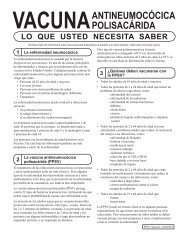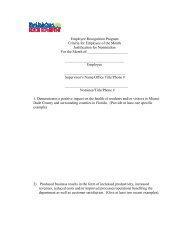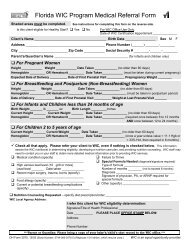MIAMI-DADE COUNTY HEALTH DEPARTMENT SPRING 2004 ...
MIAMI-DADE COUNTY HEALTH DEPARTMENT SPRING 2004 ...
MIAMI-DADE COUNTY HEALTH DEPARTMENT SPRING 2004 ...
Create successful ePaper yourself
Turn your PDF publications into a flip-book with our unique Google optimized e-Paper software.
Women and Coronary Heart Disea<br />
ELENI D.<br />
SFAKIANAKI,<br />
M.D., M.S.P.H.<br />
MDCHD Medical<br />
Executive<br />
Director<br />
Coronary heart disease -<br />
part of the overall classification<br />
of Cardiovascular<br />
Diseases (CVD)- continues<br />
to be the leading cause of<br />
death in the United States,<br />
and in many other developed<br />
nations. Death rates<br />
from CVD have been going<br />
down over the last several<br />
decades. However, despite<br />
an overall reduction, the rate<br />
of decline is less for women<br />
than for men. In terms of<br />
total deaths, in every year<br />
since 1984, CVD has claimed the lives of more<br />
females than males. And the gap between male<br />
and female deaths is wide, as the graph below<br />
shows:<br />
It is estimated that one in two women will eventually die<br />
Misperceptions still exist that CVD is not a real<br />
problem for women. Many people still believe<br />
that "heart disease is a man's disease."<br />
However, the harsh reality is that:<br />
Cardiovascular diseases cause about a<br />
death a minute among women, claiming more<br />
than one half million female lives every year.<br />
That is more lives than the next 7 causes of<br />
death in women combined.<br />
It is estimated that one in two women will<br />
eventually die of heart disease or stroke, compared<br />
with one in 25 who will eventually die of<br />
breast cancer.<br />
Starting at age 75, the prevalence of CVD<br />
among women is higher than that among men.<br />
Nearly two thirds of women who die suddenly<br />
have no previously recognized symptoms.<br />
CVD is a particularly important problem<br />
among minority women. The death rate due to<br />
CVD is 69 percent higher in black women than in<br />
white women.<br />
The good news is that, according to the<br />
literature, overwhelming evidence suggests<br />
that CVD can be prevented to a large<br />
extent in both men and women. As we<br />
know, several factors raise the risk of heart<br />
disease. These include:<br />
Increasing age<br />
Gender<br />
Heredity and race<br />
High blood cholesterol<br />
High blood pressure<br />
Tobacco smoke<br />
Physical inactivity<br />
Obesity or overweight and<br />
Diabetes.<br />
Addressing these factors and effectively<br />
modifying or controlling them, can substantially<br />
reduce the risk for CVD. Of course,<br />
some of these factors, namely the first<br />
three ones, cannot be modified: we cannot<br />
turn the clock back nor can we change our<br />
gender and our family history. However,<br />
both men and women can do a lot to modify<br />
or control the other risk factors: high<br />
blood cholesterol, high blood pressure,<br />
tobacco smoke, physical inactivity, obesity<br />
or overweight and diabetes.<br />
11<br />
HealthBeat
















